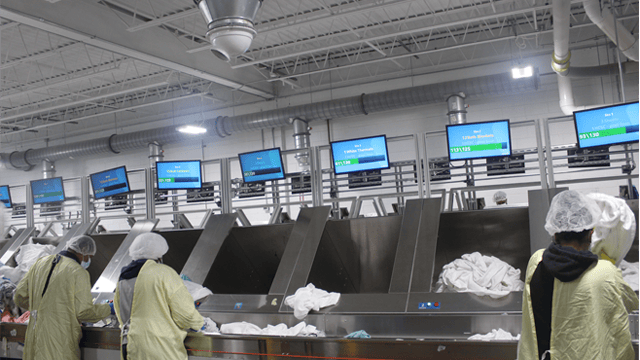Coming Next Month … HCSC Camden Plant Profile

February’s Textile Services magazine will include a feature article on a recently refurbished, highly automated healthcare plant, the HCSC Laundry in Camden, NJ.
This facility underwent renovations during the COVID-19 pandemic; it reopened in January 2021. Equipped with modern machinery and a proactive approach to quality and customer service, HCSC has expanded its throughput from 30,000 lbs. (13,607 kg.) per week at the reopening to 450,000 lbs. (204,116. kg.) today.
The plant operates at 145 lbs. per operator hour (PPOH). This helps HCSC compete with laundries vying for healthcare textile business in the Philadelphia metro area. The Camden plant is a 37,700-square-foot (3,437-square-meter) facility that was built to handle 25 million lbs. (11.3 million kg.) per year. Situated on the Delaware River waterfront near the Walt Whitman Bridge, HCSC is ideally situated to serve hospitals in New Jersey and nearby Philadelphia through its easy access to interstates 76, 676 and 95.
Inside the plant, readers of February’s article, titled “HCSC Camden: Renovation, Automation Power Healthcare Plant,” will see an array of modern equipment, from soil sort all the way to packout. For example, there’s a JENSEN Futurail TransSort system where staff sort textiles. A U-shape configuration on a mezzanine level is equipped with 36 floor-mounted bins with built-in weight scales. When the textiles reach a set weight, they drop onto a conveyor belt that leads to a sling that moves to one of two JENSEN Senking tunnel washers. Each tunnel has 14, 130 lb. (59 kg.) pockets. Both tunnels have a UV light at the end to help ensure cleanliness.
Clean goods move to the dryers via an automated system, which is enclosed with fencing to restrict access and ensure employee safety. From there, goods head to the flatwork ironer lines. At its Camden plant, HCSC has deployed thermal ironers for the first time. Bath and thermal blankets are processed on a JENSEN Express Blanket system that handles the feeding, folding, stacking and conveying of these items. Bed linens are processed on a JENSEN Express Trio machine. A JENSEN Turnus automatically separates pillowcases prior to feeding them to the small-piece machines. This machine turns to break up “cakes” of linens and feeds smaller loads to employees that are easier for staff to run through an ironer. After these items are processed, a JENSEN Bottom-Up Stacker stacks the pillowcases and moves them via a conveyor belt to the packout area where they’re loaded onto carts for delivery to customers.
Click here for a sneak preview of the HCSC plant profile.
